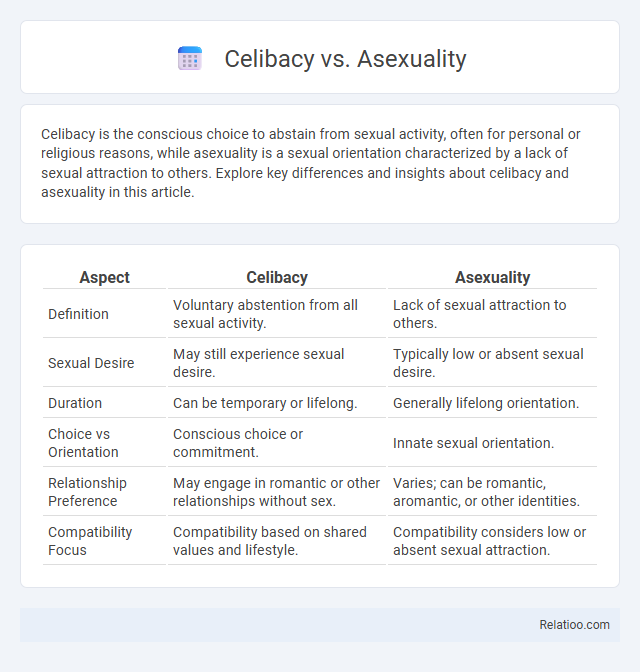Celibacy is the conscious choice to abstain from sexual activity, often for personal or religious reasons, while asexuality is a sexual orientation characterized by a lack of sexual attraction to others. Explore key differences and insights about celibacy and asexuality in this article.
Table of Comparison
| Aspect | Celibacy | Asexuality |
|---|---|---|
| Definition | Voluntary abstention from all sexual activity. | Lack of sexual attraction to others. |
| Sexual Desire | May still experience sexual desire. | Typically low or absent sexual desire. |
| Duration | Can be temporary or lifelong. | Generally lifelong orientation. |
| Choice vs Orientation | Conscious choice or commitment. | Innate sexual orientation. |
| Relationship Preference | May engage in romantic or other relationships without sex. | Varies; can be romantic, aromantic, or other identities. |
| Compatibility Focus | Compatibility based on shared values and lifestyle. | Compatibility considers low or absent sexual attraction. |
Understanding Celibacy: Definition and Origins
Celibacy refers to the voluntary choice to abstain from sexual activity, often for religious, spiritual, or personal reasons, with roots tracing back to ancient religious traditions such as Christianity, Buddhism, and Hinduism. This practice emphasizes self-discipline and spiritual growth, distinguishing it from asexuality, which is a sexual orientation characterized by a lack of sexual attraction to others. Understanding celibacy requires exploring its cultural and historical contexts, highlighting its role in shaping individual behavior and communal values over time.
What is Asexuality? Key Concepts Explained
Asexuality is a sexual orientation characterized by a lack of sexual attraction to others, distinct from celibacy, which is a voluntary choice to abstain from sexual activity. Unlike celibacy, asexuality is an inherent part of a person's identity and can include varying degrees of romantic attraction or desire for intimacy. Understanding your asexuality involves recognizing it as a legitimate orientation, not a phase or a result of personal decisions about sexual behavior.
Celibacy vs Asexuality: Core Differences
Celibacy is a conscious choice to abstain from sexual activity, often for personal, spiritual, or religious reasons, while asexuality is a sexual orientation characterized by a lack of sexual attraction to others. Unlike celibacy, which is a temporary or voluntary behavior, asexuality is an inherent aspect of your identity that persists regardless of decisions about sexual activity. Understanding the core differences between celibacy and asexuality helps clarify how sexual behavior and sexual attraction function independently in human experience.
Motivations Behind Celibacy
Motivations behind celibacy often stem from personal, spiritual, or religious convictions that prioritize abstaining from sexual activity to achieve inner peace or moral discipline. Celibacy differs from asexuality, where an individual experiences little or no sexual attraction, as celibacy is a chosen lifestyle rather than an inherent orientation. Your decision to embrace celibacy may be influenced by cultural values, ethical beliefs, or a desire for self-control rather than a lack of sexual desire.
The Spectrum of Asexuality
The spectrum of asexuality encompasses individuals who experience little to no sexual attraction, ranging from gray-asexuality to demisexuality, highlighting the diversity within asexual identities. Celibacy, a voluntary choice to abstain from sexual activity, contrasts with asexuality, which relates to an innate lack of sexual attraction rather than behavior. Understanding these distinctions is crucial for recognizing the broad range of experiences and identities within human sexuality.
Social and Cultural Perspectives
Celibacy, a voluntary choice to abstain from sexual activity often rooted in religious or cultural traditions, contrasts with asexuality, an innate sexual orientation characterized by little or no sexual attraction. Social perspectives on celibacy emphasize discipline and spiritual growth, whereas asexuality increasingly gains recognition and validation as a legitimate identity challenging heteronormative norms. Understanding these distinctions enhances your awareness of diverse human experiences shaped by cultural values and social acceptance.
Myths and Misconceptions
Celibacy is often mistakenly equated with asexuality, but celibacy is a conscious choice to abstain from sexual activity, while asexuality is an inherent sexual orientation characterized by a lack of sexual attraction. A common myth is that celibates lack sexual desire, when in reality, they may experience it but choose to remain celibate for personal, religious, or health reasons. Asexual individuals are frequently misunderstood as being celibate or repressing sexual feelings, yet they naturally do not experience sexual attraction and do not choose this state.
Psychological and Emotional Impacts
Celibacy, a deliberate choice to abstain from sexual activity, can lead to increased self-discipline and emotional clarity, while asexuality, a sexual orientation characterized by a lack of sexual attraction, often fosters a deeper understanding of personal identity without the pressure of societal norms. Celibacy and asexuality differ significantly in their psychological impacts; celibacy might induce feelings of deprivation or empowerment depending on personal reasons, whereas asexuality typically brings a sense of affirmation and reduced sexual anxiety. Understanding these distinctions helps you navigate emotional well-being and mental health by recognizing how sexual choices or orientations influence personal fulfillment and relational dynamics.
Navigating Relationships and Identity
Navigating relationships and identity requires understanding the distinctions between celibacy, asexuality, and abstinence, each representing unique experiences regarding sexual activity and attraction. Celibacy is a conscious choice to refrain from sexual activity, often for religious or personal reasons, while asexuality is a sexual orientation characterized by a lack of sexual attraction to others. Abstinence refers to temporarily avoiding sex, usually for specific personal or health-related reasons, making clear communication essential for healthy relationship dynamics in all cases.
Acceptance and Representation in Society
Celibacy, a deliberate choice to abstain from sexual activity, and asexuality, a sexual orientation characterized by a lack of sexual attraction, both face challenges in acceptance and representation within society. While celibacy is often respected in religious or spiritual contexts, asexuality struggles for visibility and understanding in mainstream media and social discourse. Your journey toward self-acceptance is crucial as increasing awareness fosters a more inclusive environment that validates diverse experiences of identity and intimacy.

Infographic: Celibacy vs Asexuality
 relatioo.com
relatioo.com